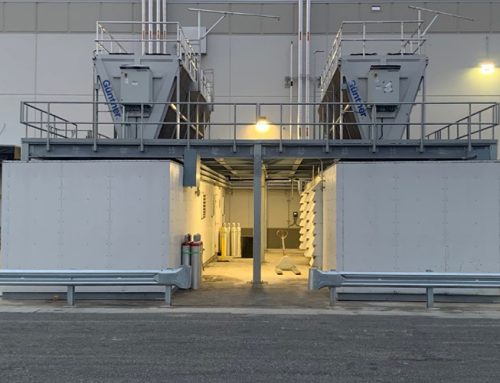What Role Does Refrigeration Play in Food and Beverage Production and Processing?
The fundamental purpose of refrigeration in industrial food and beverage production and processing is to keep food cold. Cold temperatures help food stay fresh longer by slowing down the activity of bacteria, thus making it less susceptible to spoilage and waste, reducing the incidence of foodborne disease, and improving the taste of the food.
The “cold chain”, with regards to food and beverage, refers to the process of managing the temperature of perishable products in order to maintain quality and safety from the point of origin through the distribution chain to the final consumer. Industrial refrigeration equipment plays a vital role in maintaining food and beverage optimal temperatures. Having a set of strict standards in cooling is key to reducing spoilage and waste and reducing the risk of foodborne illnesses caused by bacteria.
Proper cooling practices throughout the cold chain are not just about food safety. They also ensure that food quality isn’t degraded by any environmental factors (e.g., humidity) resulting in spoilage or contamination and subsequent food waste. Maintaining temperature control of the “cold chain” on the production floor is critical and extends to the post-manufacturing transportation and storage of the produced products.
There are a variety of options for refrigeration processes employed in the production and processing of food. Among some of the most common are:
- Pre-cooling: Rapid cooling slows the metabolism of food products serves to increase their usable life. The quality and longevity of the food products is a function of the temperature — the lower, the better. Based on the type of the food product, different refrigeration techniques are utilized. For example, small fruits receive hydrocooling, green leafy vegetables are vacuum cooled, meat product surfaces are subjected to blast-air system cooling, milk and other dairy products are cooled in specialized tanks, while pulsed air is used for a variety of other products.
- Chilling: After the food product has been pre-cooled, it must be chilled and maintained at the specific temperature required for that food. Chilling a food product reduces the risk of bacterial growth. Rapidly chilling a product (also known as flash freezing or cryogenic freezing) mitigates this risk even further. The chilling process reduces the temperature of the food and maintains it in a range between -1°C to 8°C depending on the type of food involved. The chilling medium in mechanically cooled chillers may be air, water, ice, or another secondary cooling agent (e.g., slurry ice), or metal surfaces (e.g., heat exchangers). Chilling is usually performed in chilling tunnels or chilling rooms. The required temperature range depends on the sensitivity of the involved product. Some examples of different product chilling temperature ranges would be:
| Chilling Temperature | Food Product |
| -1ºC(30ºF) to +1ºC(34ºF) | Fresh fish, breaded fish, smoked meat, ground meat, meat, and sausages |
| 0ºC(32ºF) to +5ºC(41ºF) | Pasteurized canned meat, milk, cream, yogurt, prepared salads, sandwiches, baked goods, fresh pasta, fresh soups and sauces, pizzas, pastries, and unbaked dough |
| 0ºC(32ºF) to +8ºC(46ºF) | Fully cooked meats and fish pies, cooked or uncooked cured meats, butter, margarine, hard cheese, cooked rice, fruit juices and soft fruits |
- Freezing: One of the most effective weapons in the fight against bacteria is freezing. Freezing is a process of lowering the temperature of a product below its solidification point. When the temperature is lowered below freezing point, microorganism growth decreases rapidly. An additional dynamic that occurs with the lowering of the product temperature below the freezing point is the reduction in free liquid water activity. This results in starving the microorganisms of the water they need to metabolize.
- Carbon dioxide (CO2) snow, also known as dry ice, is a very effective and easy-to-use cooling medium. At atmospheric pressure, liquid carbon dioxide converts to solid carbon dioxide snow at –79ºC (–109ºF). The solid phase of CO2 makes it extremely effective for products in processed in mixers, blenders, containers, cartons, and combos.
- Supercooling and Superchilling: Supercooling and superchilling tests have demonstrated the potential to enable safe, high quality and long-term storage of food without detrimental food quality effects for the consumer. In addition, reduced heat loads and higher storage temperatures result in energy and environmental benefits.
Supercooling is the process of lowering the temperature below its freezing point but without freezing. Superchilling allows a low ice fraction by partial freezing so that only a small proportion of the water content is in the form of ice.
These technologies have shown their ability for maintaining quality and freshness in a variety of foodstuff, in particular fish and meat, but also vegetables. They offer a more efficient method of preservation compared to deep freezing, as it is both faster to achieve and requires less energy. One of the main advantages of superchilling is that, because ice is not required to transport the foodstuff, the space taken by the ice can be replaced by food, decreasing the number of required journeys.
Shelf-life improvement of up to 100 % compared with traditionally chilled products has been estimated, which results in a significant waste reduction.
- Other Food Processes Involving Refrigeration: Refrigeration is also used in many other industrial food processes. Some examples of these are:
- Crystallization of fat for the texturization of butter, margarines, and some soft cheeses.
- Cryoseparation of undesirable components, such as tartaric acid in white wines and champagne.
- Cryoconcentration of components, as is done with fruit juices.




